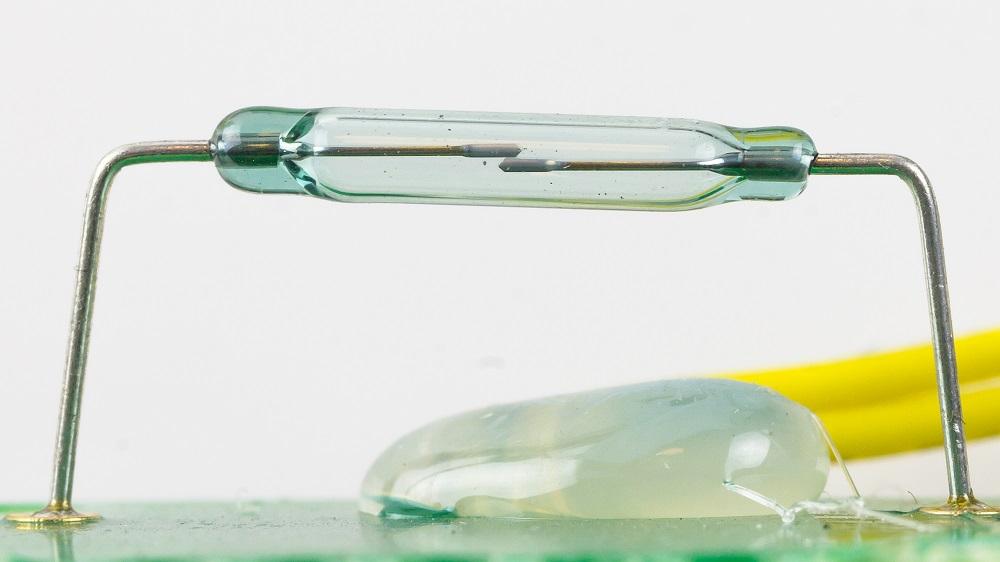Reed Switch: An Important Electromagnetic Component

The reed switch, also known as a reed relay, is a basic electromechanical device that relies on the response of magnetic materials to control the opening and closing of contacts inside the switch or relay. Reed switch devices have been used for a variety of applications for over 70 years due to their simplicity, reliability, and durability. In this article, we will explore the basic workings of the reed switch, as well as cover some major applications and upcoming enhancements being made to this technology.
How a Reed Switch Works
A reed switch consists of a hermetically sealed glass tube containing two finely spaced metal contacts and two ferromagnetic reed blades that are mounted at both ends of the glass capsule. When no external magnetic field is present, the reed blades remain apart due to their natural resilience. However, when a strong external magnetic field is applied near the reed switch, the reed blades bend and touch, thereby closing the reed switch circuit. When the magnetic field is removed, the reed blades spring back to their original positions, opening the circuit again.
The simple operation of the reed switch makes it well suited for applications involving electromechanical devices that require robust contact reliability with very low current ratings. Some key attributes of reed switch components include contact resistance less than 1 ohm, contact ratings up to several hundred milliamps, reliable operation even with vibrations up to 10,000Gs, and operational life spans ranging from millions to billions of actuation cycles depending on application conditions.
Common Reed Switch Applications
Due to their basic design and reliable operation, Reed Switch Device have found use in a wide variety of commercial and industrial applications. Here are some of the most common uses for reed switch technology:
- Security and access control systems: Magnetic door/window sensors, perimeter alarms, motion detectors
- Appliance controls: Ovens, washing machines, air conditioners, light dimmers
- Instrumentation: Flow meters, level detectors, pressure sensors
- Telecommunications: Telephone circuitry, fiber optic systems, network equipment
- Automotive applications: Ignition systems, door locks, sensors
- Medical devices: Pacemakers, infusion pumps, sensors, monitors
- Aviation equipment: Navigation, communication, auto-pilot controls
- Robotics: Position detection, motion controls, safety monitors
Newer Applications and Enhancements
In recent years, researchers have developed new techniques to enhance reed switch performance and enable newer applications. Some examples include:
Micro-miniature reed switches: Advances in microfabrication have enabled reed switches with sizes as small as 0.3mm x 0.6mm for applications like medical implants, small sensors, etc.
Hermetically sealed reed switches: Using advanced glass sealing and encapsulation enables operational lifetimes exceeding 50 million actuations in harsh environments like automotive and industrial settings.
Solid-state reed switches: Combining reed components with solid-state electronics allows for additional signal processing functions like amplification, higher contact ratings and operational speeds comparable to transistors. Promising for security equipment, factory automation, etc.
Wireless reed switches: Integrating miniature reed switches with RFID or Bluetooth modules enables truly wireless security/alarm systems, medical patches, environmental monitors and more with long battery lives.
Magnetic field programmable reed switches: By modifying the glass or reed compositions, some switches can now be programmed to respond to unique magnetic field strengths/frequencies for tagging and authentication applications.
More Reliable and Efficient Reed Switches Ahead
With continued materials research and microfabrication advances, the capabilities of reed switches will only improve further while retaining their inherent design benefits like simplicity and reliability. Applications in areas like IoT sensors, medical devices, autonomous systems and industrial controls are also poised to expand dramatically in the coming years. Overall, the basic but elegant mechanism of responding to magnetic fields through flexing reed blades will likely keep this electromechanical component relevant for both traditional uses as well as newer applications not yet envisioned.
Get more insights on- Reed Switch Device
Check more trending articles related to this topic: Spinal Cord Injury Therapeutics Market
- Art
- Causes
- Crafts
- Dance
- Drinks
- Film
- Fitness
- Food
- Giochi
- Gardening
- Health
- Home
- Literature
- Music
- Networking
- Altre informazioni
- Party
- Religion
- Shopping
- Sports
- Theater
- Wellness
- IT, Cloud, Software and Technology


